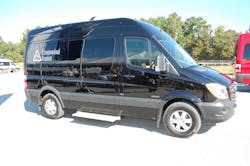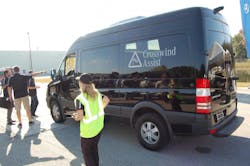During a special ride and drive event held at its Sprinter van U.S. re-assembly plant just outside Charleston, SC, Daimler AG’s Mercedes-Benz USA (MBUSA) division showed off a new safety technology upgrade for the 2015 model Sprinter dubbed “Crosswind Assist.”
Planned as a standard feature on 2015 Sprinter 2500 models, Crosswind Assist uses additional software algorithms within the van’s electronic stability program (ESP) architecture to compensate for the effects of wind gusts on vehicles – reducing the need for sudden counter-steering maneuvers and thus by extension reducing the risk of crashing due to driver overreaction.
“We’re quite convinced a lot of accidents due to sudden bursts of wind,” Mathias Geisen, GM-product management/marketing for MBUSA’s commercial van group, told Fleet Owner at the event.
“Normally we don’t just focus on one safety feature like this, but based on our testing, we believe that over the next few years it will become a very important safety enhancement worldwide to the Sprinter,” he added.The OEM explained that Crosswind Assist detects forces acting on the vehicle by referencing data supplied by sensors for yaw rate and lateral acceleration that are part of the van’s standard electronic stability program (ESP).
The Crosswind Assist piece of the ESP system only activates after the vehicle exceeds 50 mph and specifically applies the brakes to individual wheels on the side facing towards the wind, preventing the van from drifting dangerously off course as a result of yawing or rotary movement.
Geisen pointed out that Crosswind Assist is specifically designed to help drivers keep the Sprinter van on course in the event of sudden crosswind gust – especially on bridges or when overtaking trucks – while driving at highway speeds.
“This is not simple; it only looks simple on the surface,” he stressed. “This type of technology has been deployed before for SUVs [sport utility vehicles] but the Sprinter is much larger vehicle.”
Geisen added that such safety technology can also be a difficult sell to customers as it cannot be “seen” by the naked eye.
“You can’t see all the research and testing costs that goes into the software sitting inside this little black box within the van,” he pointed out.
“And while safety is a concern for everyone, many don’t want to pay for it, so that’s why it’s always important doe us to balance what technology we make standard,” Geisen added. “In this case, we believe this will have an extremely positive impact on accident statistics within the van segment.”
About the Author
Sean Kilcarr
Editor in Chief
Sean Kilcarr is a former longtime FleetOwner senior editor who wrote for the publication from 2000 to 2018. He served as editor-in-chief from 2017 to 2018.

